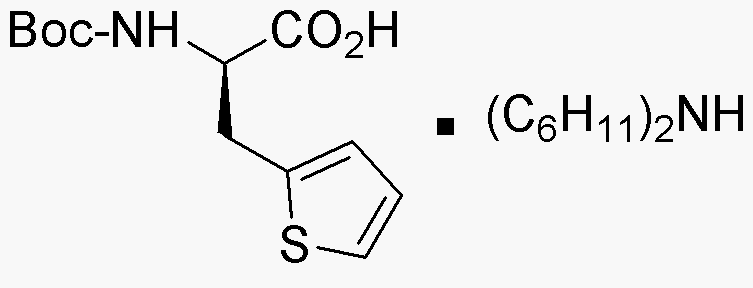Boc-b-(2-thienyl)-D-alanine dicyclohexylammonium salt is widely utilized in research focused on:
- Peptide Synthesis: This compound serves as a protecting group in peptide synthesis, allowing for the selective modification of amino acids without interfering with other functional groups. This is particularly useful in the pharmaceutical industry for developing new drugs.
- Drug Development: Its unique structure can enhance the bioavailability of therapeutic agents, making it valuable in the design of more effective medications, especially in oncology and neurology.
- Biochemical Research: Researchers use this compound to study protein interactions and enzyme activity, contributing to advancements in molecular biology and biochemistry.
- Material Science: The compound can be incorporated into polymer matrices to create materials with specific properties, such as improved thermal stability or enhanced mechanical strength, benefiting industries like aerospace and automotive.
- Analytical Chemistry: It is employed as a standard in chromatographic techniques, aiding in the accurate analysis of complex mixtures in various fields, including environmental testing and food safety.
General Information
Properties
Safety and Regulations
Applications
Boc-b-(2-thienyl)-D-alanine dicyclohexylammonium salt is widely utilized in research focused on:
- Peptide Synthesis: This compound serves as a protecting group in peptide synthesis, allowing for the selective modification of amino acids without interfering with other functional groups. This is particularly useful in the pharmaceutical industry for developing new drugs.
- Drug Development: Its unique structure can enhance the bioavailability of therapeutic agents, making it valuable in the design of more effective medications, especially in oncology and neurology.
- Biochemical Research: Researchers use this compound to study protein interactions and enzyme activity, contributing to advancements in molecular biology and biochemistry.
- Material Science: The compound can be incorporated into polymer matrices to create materials with specific properties, such as improved thermal stability or enhanced mechanical strength, benefiting industries like aerospace and automotive.
- Analytical Chemistry: It is employed as a standard in chromatographic techniques, aiding in the accurate analysis of complex mixtures in various fields, including environmental testing and food safety.
Documents
Safety Data Sheets (SDS)
The SDS provides comprehensive safety information on handling, storage, and disposal of the product.
Product Specification (PS)
The PS provides a comprehensive breakdown of the product’s properties, including chemical composition, physical state, purity, and storage requirements. It also details acceptable quality ranges and the product's intended applications.
Certificates of Analysis (COA)
Search for Certificates of Analysis (COA) by entering the products Lot Number. Lot and Batch Numbers can be found on a product’s label following the words ‘Lot’ or ‘Batch’.
*Catalog Number
*Lot Number
Certificates Of Origin (COO)
This COO confirms the country where the product was manufactured, and also details the materials and components used in it and whether it is derived from natural, synthetic, or other specific sources. This certificate may be required for customs, trade, and regulatory compliance.
*Catalog Number
*Lot Number
Safety Data Sheets (SDS)
The SDS provides comprehensive safety information on handling, storage, and disposal of the product.
DownloadProduct Specification (PS)
The PS provides a comprehensive breakdown of the product’s properties, including chemical composition, physical state, purity, and storage requirements. It also details acceptable quality ranges and the product's intended applications.
DownloadCertificates of Analysis (COA)
Search for Certificates of Analysis (COA) by entering the products Lot Number. Lot and Batch Numbers can be found on a product’s label following the words ‘Lot’ or ‘Batch’.
*Catalog Number
*Lot Number
Certificates Of Origin (COO)
This COO confirms the country where the product was manufactured, and also details the materials and components used in it and whether it is derived from natural, synthetic, or other specific sources. This certificate may be required for customs, trade, and regulatory compliance.

